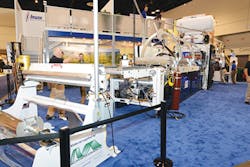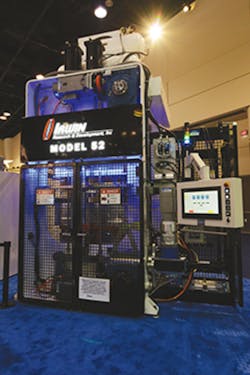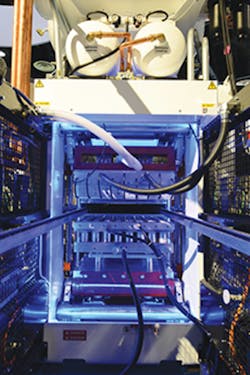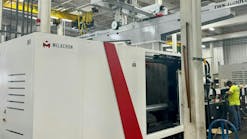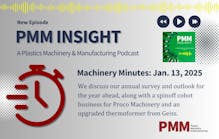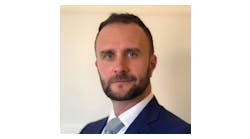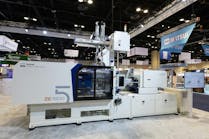With the unveiling of two thermoformers at NPE2018, Irwin Research & Development showed off the fruits of a year's labor. Its new Model 45 and Model 52 thermoformers take advantage of a new measuring system and boast exceptional precision and flexibility.
The machines are so new that both were designed and manufactured in the year leading up to NPE2018, said Dale Vantrease, new design and manufacturing concepts supervisor. At press time, the company had five patents pending, he said.
The machines are heavy-duty, solid-sheet models with large shut heights and strokes for products with a larger depth of draw. Model 45 has a shut height of 2.5 feet with a maximum stroke of 8 inches and a 5-inch depth of draw; its maximum sheet width is 4 feet and it has a maximum clamping force of 125 tons. With a shut height of 2.75 feet and maximum stroke of 9 inches, Model 52 has a depth of draw of up to 8 inches; it produces sheets as wide as 4.58 feet with a maximum clamping force of 200 tons.
The machines have a SASH mechanism — that acronym stands for servo-adjustable shut height — built into their frames that establishes and maintains precise shut height.
"The SASH has an extra motion that happens after the platens are in the closed position in the former," Vantrease said. The frame, platen and platen-drive mechanism are subjected to pressure by the air that is inserted into the tool to form the product. The SASH moves as the forming air is being applied to the tool.
"We can monitor the movement by using our new measuring system technology to ensure the mold gap stays the same as it was set up by the tool setters," he said. The measuring system monitors the movement of the frame and communicates with the HMI, which allows the user to set limits to prevent damage to the machine. It lets users know when the pressure difference from one corner of the tool to another exceeds parameters.
"If the measuring system sees a maximum tonnage limit, it will open the platen set and allow the sheet to index to prevent a fire in the heat tunnel," Vantrease said. The measuring system also allows for thermal control of the frame. The system monitors the frame for differences in temperature from the entrance of the thermoformer frame where the heat tunnel is located to the frame exit.
"We now have a system that will monitor the frame and keep the mold gap to plus or minus 0.001 of an inch," he said. When a bigger gap is detected, the system cools the frame until it is back to its set point.
"It is very important to keep the mold gap the same after the machine has been put into production," Vantrease said. "The thickness of each product that is formed is critical in some products."
The machines also boast new designs for the toggle shafts and platens.
Now, bottom toggle shafts are at the lowest point in the frame and top toggle shafts are at the highest point on the frame. In the past, the toggle shafts were closer to the horizontal sheet line of the machine.
"By moving the toggle shafts further apart, we allow for larger strokes and shut heights in the same size machine," Vantrease said.
The new design has a two-piece platen instead of a one-piece platen. Previously, the load transfer path from the outer part of the former to the platen set would create a bow between the platens from one side to the other. "This caused problems when needing to run products that required high form-air pressures and required the tool gap to maintain plus or minus 0.001 of an inch tolerance," he said. In the new design, the tooling side of the platen is under compression and the secondary support that is connected to the toggle mechanism that drives the platen up and down is under tension. The design has adjustable positions for the connection between the tool side of the platen and the secondary side of the drive platen.
Overall, the design provides greater flexibility in the types of platens that can be used.
"These style [of] platens have the ability to remove the tooling plate and be replaced with another tooling plate that is configured to hold a different style of tooling without removing the platen set," he said. "The platens also have the ability to be removed as a set without removing the die post."
During NPE2018, the Model 52 thermoformer on display held a 0.002-inch tolerance between the top and bottom platens while running with 180 tons of clamping force.
The patent-pending technologies are also being used in the Irwin Crossover series. These machines can process either solid or foamed sheet. Models 45 and 52 are dedicated to solid sheet but Irwin's standard Model 50 is considered part of the new Crossover series.
"This is based on our older foam lines that we have made for years and allows the customer to have a machine that will not only do foam products but has the ability to change over to solid sheet as the industry dictates," Vantrease said.
Angie DeRosa, managing editor
Contact:
Irwin Research & Development Inc.Yakima, Wash., 509-248-0194,
